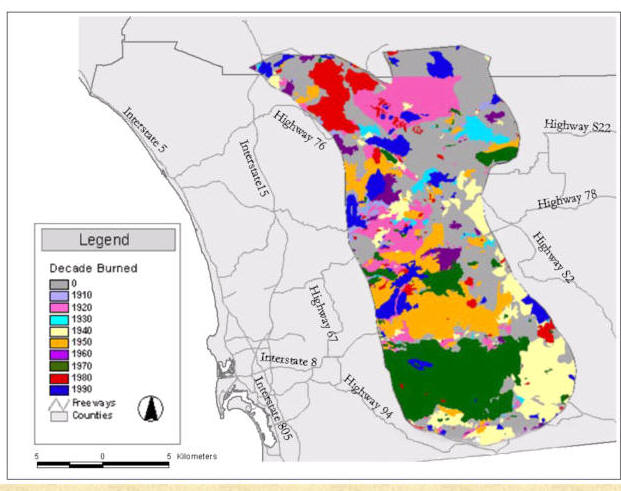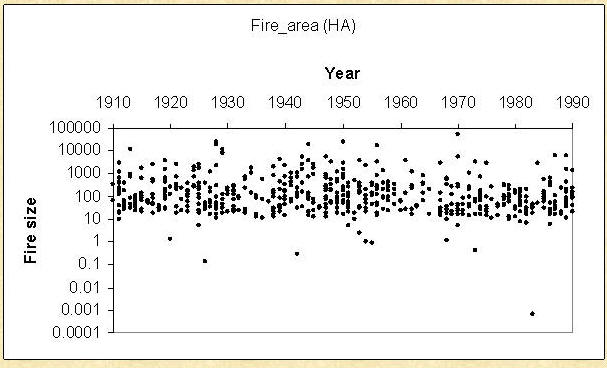(Except from manuscript in preparation, Oct 30, 2003)
An ecosystem’s disturbance regime is defined by parameters describing the recurrence, location, and severity of natural disturbance such as fire, e.g., size, return interval, intensity (Pickett and White 1985, Turner et al. 1989, Johnson 1992). When disturbance is infrequent, average parameters can be hard to define as the frequency of the disturbance is of the same order of magnitude as changes in the causal factors such as decadal fluctuations and longer-term trends in climate, and human impacts (Zedler 1995, Keeley and Fotheringham 2003).
In southern California, the plant communities comprise species that tolerate fire by various methods of resistance or resilience, or in some cases require fire for regeneration (Keeley and Zedler 1978, Keeley 1986, Keeley, Zedler 1995). The shrublands that cover the greatest area in the foothills and remaining undeveloped coastal plain (Stephenson and Calcarone 1999) burn in stand-replacing fires (Keeley and Fotheringham 2001). Therefore, it is difficult to reconstruct fire histories and vegetation response using dendroecological methods (fire scars) that, when combined with palynological data, have proved so useful in forests (e.g., McBride and Laven 1976, Agee et al. 1978, Anderson and Carpenter 1991).
Charcoal in sediment cores, historical, and ethnographic data (Lewis 1973, Mensing et al. 1999, Keeley 2002) provide insights into long-term trends in the shrubland fire regime in southern California, but lack spatial detail. Detailed fire mapping has only been carried out for the 20th century, primarily during the modern period of fire suppression, while people have affected the fire regime in this region in various ways for 400 years during the historic period, and prehistorically throughout the Holocene (reviewed by Keeley and Fotheringham 2003).
The available data suggest that the in the second half of the 20th century the frequency of small fires increased in southern, coastal California, while their average size decreased (Keeley et al. 1999, Moritz 2003). In San Diego County, this has resulted in an increased rate of burning (area burned per decade) in coastal shrublands (especially the coastal sage scrub formation), although no trend could be detected for the chaparral formation of the foothills and mountains, more distant from urban development (Wells et al. submitted). This pattern is consistent with a causal explanation of increased human-caused ignitions along the lower-elevation wildlands-urban interface (with suppression efforts keeping many of those fires small), contrasting with effective fire suppression in the upper-elevation montane forests (Keeley and Fotheringham 2003, Wells et al. submitted).
It has also been suggested that 20th century fire suppression has resulted in fewer, larger, high intensity fires in chaparral owing to fuel accumulation (Minnich and Dezzani 1991, Chou et al. 1993, Minnich 1995, Minnich 2001) but the evidence for this has been refuted (Keeley and Fotheringham 2001, Moritz 2003). For example, based on charcoal deposited in marine sediments in the Santa Barbara Channel, it appears that for at least 560 years (predating the Spanish period) large fire events in the region have been associated with extreme fire weather, and most of the land area burned is consumed in those large fires (Moritz 1997, Mensing et al. 1999). This suggests that modern fire suppression efforts have not increased the risk of large fires by allowing fuel to build up.
For example, data for over 600 fires in the San Diego Foothills and Mountains (Figure 1) from 1910-1999 show that the area burned per decade during the historical period of fire suppression does not show any increasing trend (Figure 2). Nor does fire size (Figure 3) – at least there does not appear to be an increase in the number of very large fires (>10,000 ha). More carefully analysis is required to determine if the trend towards increasing numbers of small fires found in other parts of southern California holds here. It may be because this study area excludes the low elevation, coastal areas and therefore much of the urban-wildland interface, that we do not see such a trend in these data. When fire history data from all of San Diego County is considered, a trend towards increasing area of low elevation coastal shrublands burned per decade is seen (Wells et al. in press). Data are from the California Department of Forestry Fire and Resource Assessment Program (http://frap.cdf.ca.gov/projects/fire_data/fire_perimeters/index.asp).

Figure 2.The San Diego County portion of the Foothills and Mountains ecoregion (Stephenson and Calcarone 1999) showing the area burned by decade, 1910-1999.

Figure 2. Area burned in the San Diego Foothills (Low Elev ~1000-4500 ft) and Mountains (High Elev <4500 ft) per decade (1=1910s… 9=1990s).

Figure 2. Fire size (ha, Log scale) in the San Diego Foothills 1910-1999 (618 recorded fires).
LITERATURE CITED
Agee, J. K., R. H. Wakimoto, and H. H. Biswell. 1978. Fire and fuel dynamics of Sierra Nevada conifers. Forest Ecology and Management 1:255-265.
Anderson, R. S., and S. L. Carpenter. 1991. Vegetation change in Yosemite Valley, Yosemite National Park, California, during the protohistoric period. Madroño 38:1-13.
Chou, Y. H., R. A. Minnich, and R. J. Dezzani. 1993. Do fire sizes differ between southern California and Baja California? Forest Science 39:835-844.
Johnson, E. A. 1992. Fire and vegetation dynamics, studies from the north American boreal forest. Cambridge University Press, Cambridge, UK.
Keeley, J. E. 1986. Resilience of mediterranean shrub communities to fire. Pages 95-112 in B. Dell, A. J. M. Hopkins, and B. B. Lamont, editors. Resilience in Mediterranean-type ecosystems. Dr W. Junk, Dordrecht.
---. 1991. Seed germination and life history syndromes in the California chaparral. The Botanical Review 57:81-116.
---. 2002. Native American impacts on fire regimes of the California coastal ranges. Journal of Biogeography 29:303-320.
Keeley, J. E., and C. J. Fotheringham. 2001. Historical fire regime in southern California shrublands. Conservation Biology 15:1536-1548.
---. 2003. Impact of past, present, and future fire regimes on North American mediterranean shrublands. Pages 218-262 in T. T. Veblen, W. L. Baker, G. Montenegro, and T. W. Swetnam, editors. Fire and climat echange in temperate ecosystems of the western Americas. Springer, New York.
Keeley, J. E., C. J. Fotheringham, and M. Morias. 1999. Reexamining fire suppression impacts on brushland fire regimes. Science 284:1829-1832.
Keeley, J. E., and P. H. Zedler. 1978. Reproduction of chaparral shrubs after fire: a comparison of sprouting and seeding strategies. American Midland Naturalist 99:142-161.
Lewis, H. T. 1973. Patterns of Indian burning in California: ecology and ethnohistory. Ballena Press, Ramona, California.
McBride, J. R., and R. D. Laven. 1976. Scars as an indicator of fire frequency in the San Bernardino Mountains, California. Journal of Forestry 74:439-442.
Mensing, S. A., J. Michaelsen, and R. Byrne. 1999. A 560-year record of Santa Ana fires reconstructed from charcoal deposited in the Santa Barbara Basin, California. Quaternary Research 51:295-305.
Minnich, R. A. 1995. Fuel-driven fire regimes of the California chaparral. in J. E. Keeley and T. Scott, editors. Brushfires in California: Ecology and Resource Management. International Association of Wildland Fire.
---. 2001. An integrated model of two fire regimes. Conservation Biology 15:1559-1553.
Minnich, R. A., and R. J. Dezzani. 1991. Suppression, fire behavior, and fire magnitudes in Californian chaparral at the urban/wildland interface. Pages 67-83 in J. J. DeVries, editor. California watersheds at the urban interface, proceedings of the third biennial watershed conference. University of California, Davis.
Moritz, M. A. 1997. Analyzing extreme disturbance events: fire in Los Padres National Forest. Ecology 7:1252-1262.
---. 2003. Spatiotemporal analysis of controls on shrubland fire regimes: age dependency and fire hazard. Ecology 84:351-361.
Pickett, S. T. A., and P. S. White. 1985. The ecology of natural disturbance and patch dynamics. Academic Press, New York, NY.
Stephenson, J., and G. M. Calcarone. 1999. Southern California mountains and foothills assessment: habitat and species conservation issues. General Technical Report PSW-GTR-172, USDA Forest Service, Pacific Southwest Research Station, Albany, CA.
Turner, M. G., R. Costanza, and F. H. Sklar. 1989. Methods to evaluate the performance of spatial simulation models. Ecological Modelling 48:1-18.
Wells, M. L., J. F. O'Leary, J. Franklin, J. Michaelson, and D. E. McKinsey. in press. Variations in a regional fire regime related to vegetation type in San Diego County, California. Landscape Ecology.
---. submitted. Variations in a regional fire regime related to vegetation type in San Diego County, California. Landscape Ecology.
Zedler, P. H. 1995. Fire frequency in southern California shrublands: biological effects and management options. Pages 101-112 in J. E. Keeley and T. A. Scott, editors. Brushfires in California wildlands: ecology and resource management. International Association of Wildland Fire, Fairfield,WA.